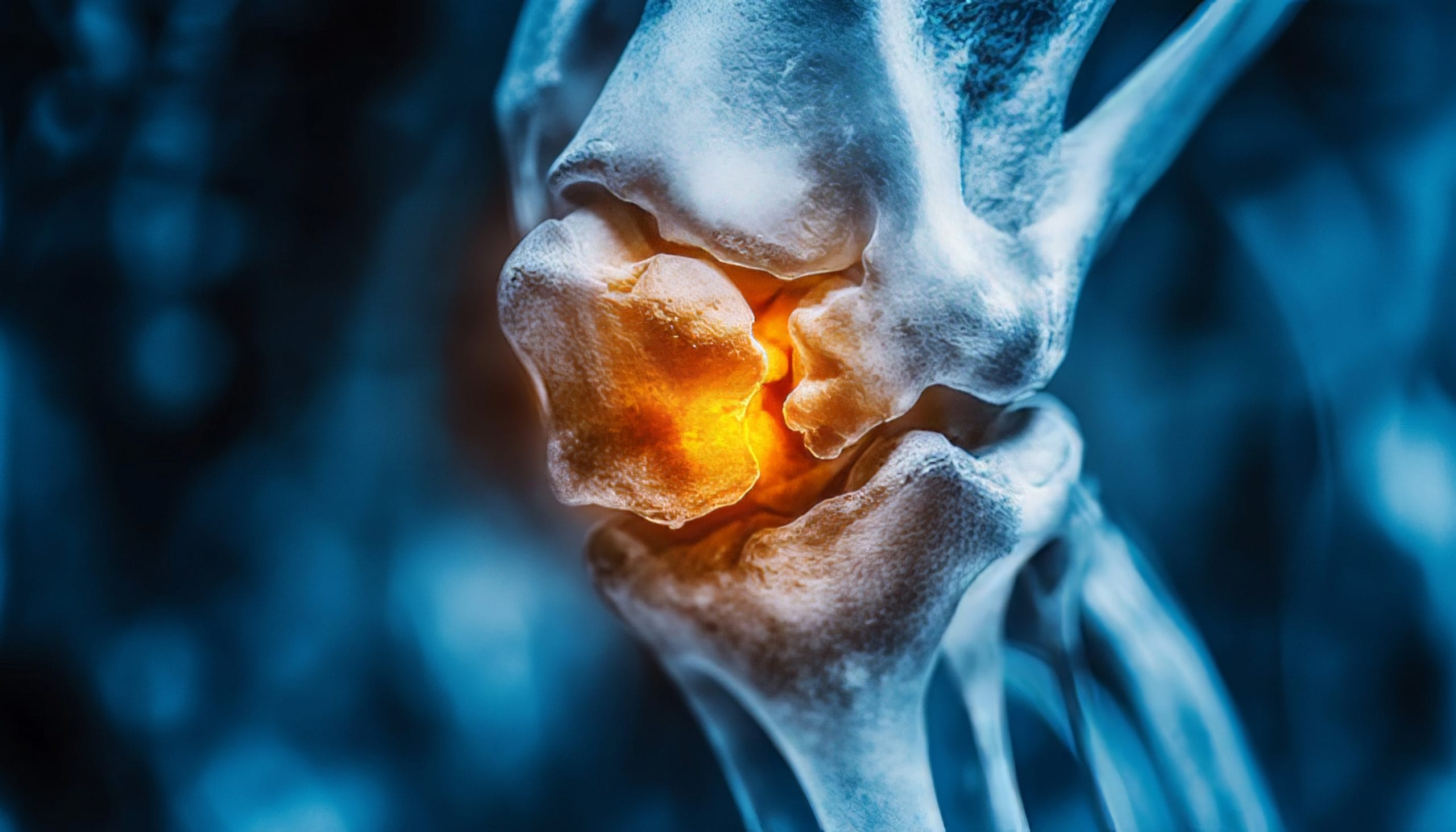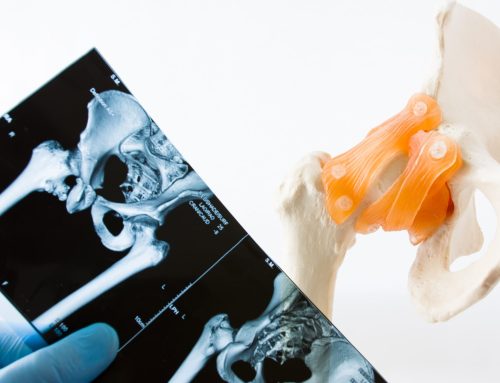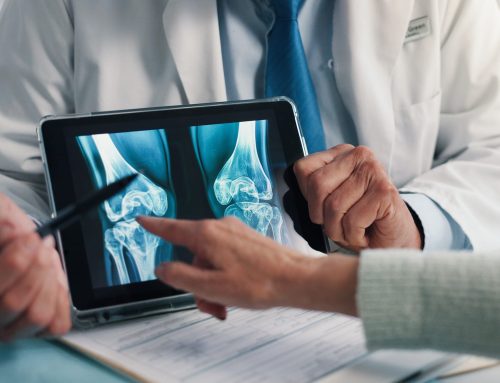That slight stiffness when you first get out of bed. The minor ache after climbing stairs. The occasional swelling after your weekend hike. These subtle changes in your knee might be easy to dismiss as “just getting older,” but they could be early signs of knee osteoarthritis.
Knee osteoarthritis affects millions of people, but it doesn’t have to define your future mobility. Recognizing the early warning signs and seeking expert evaluation can help you take control of your knee health before symptoms progress.

TL;DR—Is it osteoarthritis in your knee?
- Early patterns to watch: Morning stiffness, pain on stairs/hills, swelling after activity, clicking/grinding, reduced bending/straightening, night aching, and subtle limping.
- When to see a specialist: Symptoms lasting 6+ weeks, growing activity limits, recurrent swelling, or gait changes.
- First-line care that helps: Targeted strengthening, activity modification, bracing, injections, and weight management where appropriate.
- What imaging adds: X-rays show joint-space narrowing and bone spurs; MRI can reveal earlier cartilage changes to guide treatment.
- Next step: Book a consultation (in-clinic or virtual) with Gateway Surgery to confirm what’s driving your symptoms and align on the right course of care.
7 Warning Signs of Knee Osteoarthritis
Knee osteoarthritis rarely announces itself with dramatic symptoms. Instead, it begins with subtle changes that gradually become more noticeable. Here are the key early indicators to watch for:
1. Morning Stiffness That Lingers
One of the earliest signs of osteoarthritis is stiffness when you first wake up or after sitting for a long time. Unlike inflammatory arthritis, where stiffness may last an hour or more, stiffness from osteoarthritis usually improves within 15–30 minutes and often feels better once the joint has been gently moved or ‘warmed up.’
2. Pain on Stairs and Hills
Activities that load your knee joint (like climbing stairs, walking uphill, or getting up from low chairs) often become uncomfortable before other activities are affected. This happens because these movements place additional stress on already-irritated joint surfaces.
3. Swelling After Activity
Notice puffiness around your knee after physical activity? This post-exercise swelling, medically called effusion, occurs when the joint lining becomes irritated and produces excess fluid. It's often one of the body's first responses to cartilage changes.
4. A Grinding Sensation
Many people notice a grinding, clicking, or crunching sensation in their knee during movement. This crepitus occurs when roughened cartilage surfaces rub together, though it's worth noting that not all joint sounds indicate problems.
5. Reduced Range of Motion
You might find that your knee doesn't bend or straighten as easily as it used to. This subtle reduction in flexibility can affect activities like squatting, kneeling, or fully straightening your leg.
6. Nighttime Aching
Persistent aching that keeps you awake or wakes you up during the night is another early sign. This type of pain often indicates inflammation within the joint that hasn't settled despite rest.
7. Subtle Changes in Your Walk
You might unconsciously favor one leg slightly, develop a minor limp, or find yourself avoiding certain movements. These compensatory patterns often develop gradually as your body tries to protect the affected joint.
The Power of Early Intervention: Evidence-Based Non-Operative Care
The encouraging news about early knee osteoarthritis is that numerous non-surgical treatments can effectively slow progression and manage symptoms. Research consistently shows that early intervention provides the best outcomes.
✓ Targeted Strengthening Programs
Strengthening the muscles around your knee—particularly the quadriceps, hamstrings, and hip muscles—can significantly reduce pain and improve function. These muscles act as shock absorbers and stabilizers, reducing stress on your knee joint. Even modest improvements in muscle strength can lead to meaningful pain reduction.
✓ Strategic Activity Modification
This doesn't mean avoiding all physical activity. Instead, it involves making smart choices about how you move. Low-impact exercises like swimming, cycling, or elliptical training can maintain fitness while reducing joint stress. Simple modifications like using handrails on stairs or choosing supportive footwear can also make a difference.
✓ Bracing and Support
Knee braces can provide stability and pain relief for many people with early osteoarthritis. Unloader braces, designed to shift weight away from the affected part of the knee, can be particularly helpful for those with cartilage damage on one side of the joint.
✓ Injection Therapies
Several injection options can provide significant relief. Corticosteroid injections can reduce inflammation and provide months of pain relief. Hyaluronic acid injections can improve joint lubrication. Options are also available to help target the nerves that communicate pain from the knee to the brain.
✓ Weight Management and Nutrition
Even modest weight loss can significantly reduce knee pain. Each pound of body weight translates to about four pounds of pressure on your knees during walking. Anti-inflammatory nutrition approaches may also help reduce joint inflammation.
Imaging: What X-Rays and MRIs Reveal
When you see a specialist about knee pain, imaging studies provide crucial information that guides treatment decisions.
→ X-Ray Findings
X-rays reveal changes in bone structure and joint spacing. They can show joint space narrowing (indicating cartilage loss), bone spurs (osteophytes), and changes in bone density. However, X-ray changes don't always correlate directly with symptoms. Some people have significant X-ray changes with minimal pain, while others have substantial symptoms with mild imaging findings.
→ MRI Benefits
X-rays are usually sufficient to diagnose osteoarthritis, as they clearly show changes in the bones and joint space. An MRI is not typically required, but in some cases it can provide additional detail about the soft tissues, such as cartilage, ligaments, and the joint lining. This may be helpful if there are concerns about other causes of pain or to better understand the overall health of the joint.
→ How Findings Shape Your Plan
Your specialist uses imaging results alongside your symptoms and physical examination to create a personalized treatment strategy. Early-stage findings often support conservative treatment approaches, while more advanced changes might indicate the need for different interventions.
Gateway Surgery's Comprehensive Evaluation Process
At Gateway Surgery, we understand that knee pain can be concerning and that you want answers quickly. Our streamlined process typically gets you in for a consultation within 1-2 weeks, allowing you to take control of your knee health without lengthy delays.
1. Your Initial Consultation
During your appointment, your orthopaedic surgeon will conduct a thorough review of your medical history, current symptoms, and any previous treatments you've tried. They'll examine your knee, assess your range of motion, and review any existing imaging studies you may have.
2. Comprehensive Assessment
We believe in looking at the complete picture. Your evaluation includes discussion of your activity level, goals, and lifestyle factors that may be affecting your knee health. This comprehensive approach ensures that your treatment plan is tailored specifically to your needs and circumstances.
3. Treatment Planning Discussion
Based on your evaluation, your surgeon will explain your diagnosis clearly and discuss all appropriate treatment options, from conservative management to advanced surgical techniques. You'll receive transparent information about what each approach involves, expected outcomes, and associated costs.
Gateway's Circle of Care Advantage
What sets Gateway Surgery apart is our comprehensive Circle of Care approach. If non-surgical treatment is recommended, our team includes physiotherapists who can design targeted exercise programs and provide ongoing support. If surgical intervention becomes necessary, you'll have access to our full multidisciplinary team, including primary care physicians, anaesthesiology consultation, and comprehensive post-operative care.
Learn more in our complete guide: What to Expect from a Consultation at Gateway Surgery
When Surgery Becomes an Option
While many people with early knee osteoarthritis respond well to conservative treatments, some may eventually benefit from surgical intervention. When non-surgical approaches have been exhausted or symptoms significantly impact quality of life, knee replacement surgery can provide dramatic pain relief and restored function.
Gateway Surgery offers state-of-the-art surgical options, including robot-assisted knee replacement technology that provides enhanced precision, improved implant positioning, and potentially faster recovery times. This advanced technology allows surgeons to create a personalized surgical plan based on your unique anatomy.
The decision to pursue surgery is always individualized and based on factors like symptom severity, response to conservative treatment, activity level, and personal goals. Our surgeons work closely with each patient to determine the most appropriate timing and approach for their specific situation.
Don’t Ignore the Early Signs
If you're experiencing early signs of knee osteoarthritis, you don't have to wait for symptoms to worsen before seeking expert care. Early evaluation and intervention can help you maintain an active lifestyle and potentially slow disease progression.
The key is not to ignore subtle changes in your knee function. Those minor aches, occasional stiffness, or post-activity swelling could be your knee's way of asking for attention. With proper evaluation and care, many people with early knee osteoarthritis continue to enjoy active, pain-free lives.
Schedule Your Knee Evaluation
Knee pain can limit your activities and cause you to worry about what the future holds. Gateway Surgery's experienced orthopaedic surgeons are here to provide expert evaluation, clear answers, and personalized treatment recommendations.
Contact Gateway Surgery today to schedule your consultation. With typically just 1-2 weeks to your appointment, you can quickly get the expert assessment you need to protect your knee health and maintain your lifestyle.




